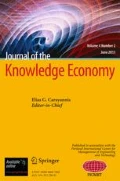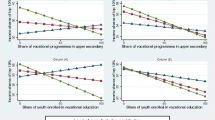Abstract
The share of STEM programs graduates in relation to the total tertiary graduates declined in Europe for the past two decades, although the expenditures for education and share of tertiary education graduates in total population increased, respectively. The quality of education, measured with the sample mean PISA scores, was almost equal to its 2000 value, lacking improvements. Simultaneously, GDP per person growth rate declined in Europe, the structural changes occurred, with growing share of the services and diminishing of the goods sectors. The share of the high-knowledge manufacturing in relation to GDP declined, which is the subsector with the highest average annual output and productivity growth rates. In services, the share of the knowledge-intensive services, respectively, increased. The descriptive statistics analysis shows strong linear association among the science and technical education, output’s structure, income per person and productivity growth. Applying the panel least square (fixed and random effects) model on the sample of thirty-five European countries and period from 1995 to 2019, we found significant contribution by STEM educated workers to output growth. Contribution to output growth by tertiary educated employees and the outcome of the investment in research and development in the high-knowledge manufacturing and knowledge-intensive services were above all sectors’ average. This is relevant as output and employment growth in these sectors surpass the same in other sectors, therefore contributing to higher income per persons and GDP growth. As STEM skills and investment in research and development have positive impact on GDP per person growth and productivity, its growth is indispensable to foster economic progress.

Source: Author’s calculation, based on PISA scores


Similar content being viewed by others
Availability of Data and Material
All data used in this research are available on request.
Notes
Science, Technology, Engineering and Mathematics.
Heinrich (2017)
Williams (2011)
Sample of 35 European countries.
Student Assessment (PISA) measures the performance of 15-year-olds, who are enrolled in either lower secondary or upper secondary education. Source of data: OECD Programme for International Student Assessment (PISA), extracted from WDB (LO.PISA.SCI), 12/11/2020.
Author’s calculation based on Eurostat data on GDP per person (chain linked 2010 euro).
Science, Technology, Engineering and Mathematics.
GDP and main components (output, expenditure and income) [nama_10_gdp].
National accounts aggregates by industry (up to NACE A*64) [nama_10_a64], extracted on 04/12/2020.
National accounts employment data by industry (up to NACE A*64) [nama_10_a64_e], extracted on 04/12/2020.
Source: World Development Indicators (original source: UNESCO Institute for Statistics).
Source: Eurostat: Intramural R&D expenditure (GERD) by sectors of performance [rd_e_gerdtot], data extracted on 12/11/20.
Engineering, Manufacturing and Construction.
Business, Administration and Law.
We also found that PISA scores strongly influence the World Bank’s Human Capital index. The HCI calculates the contributions of health and education to worker productivity. The final index score ranges from zero to one, and measures the productivity as a future worker of a child born today relative to the benchmark of full health and complete education.
Sample was reduced due to missing data for four countries (Montenegro, Serbia, Albania and Turkey).
Source: Eurostat: Cross-classification of fixed assets by industry and by asset (stocks) [nama_10_nfa_st], data extracted on 12/11/20.
Some structural data were not available for following countries: Luxemburg, Malta, Poland, Sweden, Iceland, Montenegro, Albania, Serbia and Turkey. Also data on employees with tertiary education in high-knowledge manufacturing and knowledge-intensive services only since 2008. All data are available on request.
Sequeira and Campos (2005).
The results of the abovementioned tests are available on request.
Available on request.
References
Amil, D., Giannoplidis, A., & Lipp-Lingua, C. (2007). Evolution of high-technology manufacturing and knowledge-intensive services. Luxembourg: Eurostat.
Barro, J. R. (1998). Macroeconomics, 5th edition. The MIT Press, Cambridge, Massachusetts, London, England.
Barro, R. (2001). Education and Economic Growth. In H. JF, The Contribution of Human and Social Capital to Sustained Economic Growth and Well-Being. OECD. Retrieved from oecd.org: https://www.oecd.org/innovation/research/1825455.pdf
Becker, S. G. (1993). Human Capital Revisited. In S. G. Becker (Ed.), Human Capital: A Theoretical and Empirical Analysis with Special Reference to Education (pp. 15–28). The University of Chicago Press.
Becker, S. G., Murphy, M. K., & Tamura, R. (1993). Human capital, fertility, and economic growth. In S. G. Becker (Ed.), Human Capital: A Theoretical and Empirical Analysis with Special Reference to Education (pp. 323–350). The University of Chicago Press.
Buera, F., & Kaboski, J. (2012). The Rise of the Service Economy. American Economic Review, 102(6), 2540–2569.
Drori, G. S. (1998). A Critical Appraisal of Science Education for Economic Development. In W. W. Cobern, Socio-Cultural Perspectives on Science Education. Dordrecht: Springer.
Foster-McGregor, N., & Verspagen, B. (2017). Decomposing Total Factor Productivity Growth in Manufacturing and Services. Asian Development Review, 34(1), 88–115.
Hanushek, E. A., & Kimko, D. D. (2000). Schooling, Labor-Force Quality, and the Growth of Nations. American Economic Review, 90(5), 1184–1208.
Heinrich, M. (2017). Retrieved from United States Congres. Joint Economic Committee: https://www.jec.senate.gov/public/_cache/files/2061de0c-be23-4cf1-ad0b-270d3f6c661e/stem-top-10-12.4-final-1-pager.pdf
Margaritis, D., Scrimgeour, F., Cameron, M., & Tressler, J. (2005). Productivity and Economic Growth in Australia, New Zealand and Ireland. Agenda: A Journal of Policy Analysis and Reform, 12(4), 291–308.
Mcmillan, M., Rodrik, D., & Verduzco-Gallo, I. (2014). Globalization, Structural Change, and Productivity Growth, with an Update on Africa. World Development, 63, 11–32.
Morro, A. (2015). Structural Change, Growth and Volatility. American Economic Journal: Macroeconomics, 7(3), 259–294.
Nelson, R. R. (2000). The Sources of Economic Growth. Harvard University Press.
OECD. (2020). Education at a Glance 2020: OECD Indicators. OECD.
Ramesh, C., & Mukhejree, S. (2020). Do Spending on R&D Influence Income? An Enquiry on the World’s Leading Economies and Groups. Journal of the Knowledge Economy, 11, 1295–1315.
Ray, R. (2015). STEM Education and Economic Performance in the American States. Retrieved from MPRA: https://mpra.ub.uni-muenchen.de/65517/
Romer, D. (2001). Advanced Macroeconomics. McGraw-Hill Higher Education.
Schleicher, A. (2019). PISA 2018: Insights and Interpretations. OECD.
Schreiber, S. (2008). The Hausman test statistic can be negative even. Retrieved from http://econ.schreiberlin.de/papers/schreiber_hausmantest_aug2008.pdf
Sequeira, T., Campos, C. (2005). International Tourism and Economic Growth: A Panel Data Approach. FEEM. Working Paper No. 141.05. https://doi.org/10.2139/ssrn.855985
Williams, J. (2011). STEM Education: Proceed with caution. Design and Technology Education: an International Journal, 16(1).
Woessmann, L. (2016). The Importance of School Systems: Evidence from International Differences in Student Achievement. Journal of Economic Perspectives, 30(3), 3–32.
Author information
Authors and Affiliations
Corresponding author
Ethics declarations
Conflict of Interest
The authors declare no competing interests.
Additional information
Publisher's Note
Springer Nature remains neutral with regard to jurisdictional claims in published maps and institutional affiliations.
Appendix
Appendix
Statistical annex
Rights and permissions
About this article
Cite this article
Bacovic, M., Andrijasevic, Z. & Pejovic, B. STEM Education and Growth in Europe. J Knowl Econ 13, 2348–2371 (2022). https://doi.org/10.1007/s13132-021-00817-7
Received:
Accepted:
Published:
Issue Date:
DOI: https://doi.org/10.1007/s13132-021-00817-7
Keywords
- STEM education
- GDP growth
- High-knowledge manufacturing
- Knowledge-intensive services
- Investment in research and development







